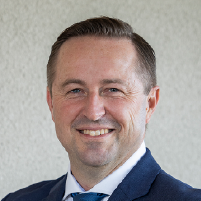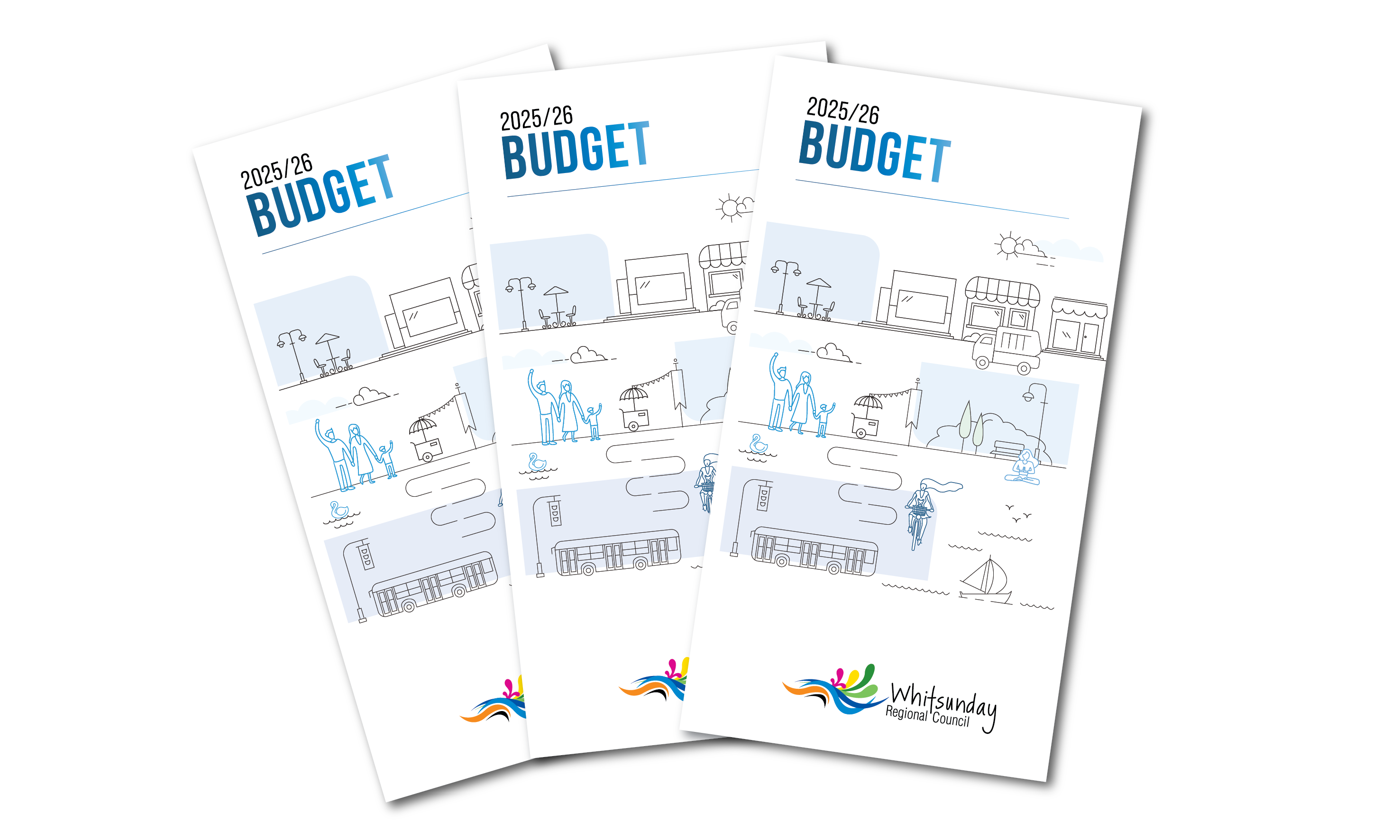Budget 2025/26
-
 On Wednesday 18th June we handed down the 2025–26 Whitsunday Regional Council Budget. This was my second as Mayor and I want to take a moment to reflect on the journey we’ve been on over the past year.
On Wednesday 18th June we handed down the 2025–26 Whitsunday Regional Council Budget. This was my second as Mayor and I want to take a moment to reflect on the journey we’ve been on over the past year.Just under twelve months ago we delivered our first budget for the term, just weeks after the new Council was sworn in. I think you’ll agree that it was necessarily shaped by the organisation. It was a starting point but not yet a statement of our long-term direction.
This year is different, we started early. This budget represents our own choices - debated and hard-fought through months of investigation, consultation, and a commitment to understanding and unpacking the real challenges and opportunities facing our organisation and our region.
It’s a budget that seeks to strike a balance: between addressing legacy issues that started before this term, refocusing our services on core responsibilities, and laying the foundations for the critical infrastructure our growing region needs for the future.
You don’t get told what you inherit, and as we’ve worked through the budget, we’ve started to understand a deeper issue in the financial structure of the organisation.
In recent years council has consistently delivered a “balanced” budget on paper, in reality we were starting to live beyond our means. Our general fund which derives its revenue from our core rates and charges had developed a structural deficit of around $10 million per year.
This growing structural deficit has been cross-subsidised by our commercial arms, namely our water and sewerage businesses - funded by payers of water and sewerage utilities charges. There’s nothing inherently wrong with that, and as a singular entity some may say to be expected but it highlighted an ideological problem:
We were continuing to deliver a wide and growing range of services - services that our community has come to expect but without the financial headroom needed to invest back into our core infrastructure to sustain our region long-term.
At the same time, we’ve been navigating the fallout from significant property revaluations brought down last year, rising inflation, and a cost-of-living crisis. Council is not immune to these. Core costs from road materials to waste collection to insurance have risen steeply across the board.
And lets not forget about our other levels of government. It should be well known in the community that local governments receive 3 cents in every dollar in the total pool of taxation revenue collected nationally with the remainder going to the state and federal governments. We maintain a large percentage of community infrastructure with very little in the scheme of things if that’s not enough the financial assistance grants we receive from them to support service delivery and roads are going down, this year by an order of $779,000 or 12%. That’s money taken from our community to be allocated somewhere else, yet we are continued to be asked to provide millions of dollars in services through cost-shifting into areas like public safety, disaster response, natural resource management and welfare. If local governments are to remain sustainable, something has to change.
Like many regional Councils, our existing rating structure has served us for many years. But as our region has grown and changed with more diverse land use, shifting property values and increasing demand for services—it’s become clear that the time is right to review and refine the way we fund our services.
To address this, late last year we initiated a full Rating System Review, bringing in independent experts (AEC) to help us undertake major reform our general rating model.
Our goals were clear: equity, simplicity, and sustainability and increase the emphasis on user pays where a user directly benefits from a service.
All Councillors participated and had ample opportunity to provide their feedback in this journey and the result is a fairer, more modern rating system designed to better reflect how our community has changed and ensure that everyone contributes their fair share. Whenever you make a change to the system some rates will go up and some rates will go down as we see with this new model.
Our residential ratepayers make up 87% of our rate base and for residential owner-occupiers, the average general rates increase is 2%, with utility charges - covering water, sewerage, and waste, increasing by around 5%. All up, the average residential household with waste collection will pay $2.92 more per week.
For general commercial and industrial ratepayers, it’s a bigger shift this includes an average increase of around 21% - roughly $14 a week. That’s not a figure we arrived at lightly. But for too long, commercial rates have failed to keep pace with property values and service demands. Likewise large ratepayers in the Resource sand Energy sectors will see a significant shift under the new model ensuring they pay their fair share in our community.
As part of our financial reform, we’re also advancing the transition of many Council fees and charges to a user-pays model—ensuring the full cost of services like waste disposal, development inspections, and facility hire is borne by those who use them, not the general ratepayer base.
This approach improves transparency, reduces cross-subsidisation and supports long-term financial sustainability so we can continue delivering high-quality services without compromising our future.
In trying to avoid sharp rises in the past, we ended up with an imbalance. This year’s budget begins the process of correcting that helps lay a more equitable foundation going forward, where everyone is contributing fairly to the services and infrastructure that support our region’s growth and prosperity.
This budget isn’t just about revenue. It’s also about how we spend smarter and deliver better.
Over the past year, we’ve reviewed our operational services function by function—looking for ways to streamline, create efficiency, and reduce duplication.
As a result, we’ve identified and enacted approximately $3 million in efficiency savings across the organisation, including in areas such as libraries, the Proserpine Entertainment Centre, environmental stewardship, community donations, communications and promotion and corporate back-of-house functions.
These savings haven’t come at the cost of quality—but they’ve helped us refocus on what matters most: delivering core services where they’re needed, when they’re needed. Moving forward we cannot afford to stop here, we need to continue to look for better more efficient ways of doing business, minimise waste and become more productive with what we have.
Conversely, some core service areas have seen an enhanced focus including boosting our operational roads and footpath maintenance by an additional $2.5 million, to ensure we’re not just building infrastructure—but maintaining it.
This year’s budget delivers a $114 million capital works program—a significant investment in the long-term strength and resilience of our region.
These investments reflect our strategic priorities and the scale of infrastructure required to support a growing, modern region.
And importantly, it lays the financial groundwork for generational infrastructure—the kinds of projects that will define and drive our region’s growth for decades to come.
Initiatives like the Cannonvale Community Hub, the Whitsunday Regional Sports Precinct, the Collinsville Community Hub and the upcoming regional precinct masterplans are not just aspirations—they are a vision and catalyst for future investment, connection, and opportunity in our community.
In summary, this is a budget that looks forward.
It acknowledges the realities of today; rising costs, ageing infrastructure and financial imbalance, while taking confident, responsible steps to get us back on solid footing.
It delivers real outcomes now. Better maintenance, fairer rates, and major infrastructure investment—while also laying the groundwork for the region we want to be in 10, 20 or 30 years’ time.
I want to thank my fellow Councillors for working together through this process. These were not always easy decisions and I’m sure there are many things we don’t entirely agree, but they were necessary.
To our staff, thank you for your professionalism and commitment to delivering a better Council for the Whitsundays.
The 2025–26 Budget is a roadmap for where we’re headed. It doesn’t solve every challenge—but it sets us on the right path: fairer, financially stable, service-focused, and future-ready.
Mayor Ry Collins
Budget Brochure
Download a copy of this year's Budget Brochure.
Financial Statements
Budget for 2025/26 Financial Year
10-year Long Term Financial Forecast
Media Release
Budget Lays Groundwork for a Fairer, Stronger Whitsundays
Budget Video
Budget Documents
Budget Documents
| # | Name | Size | File Type | Download |
|---|

